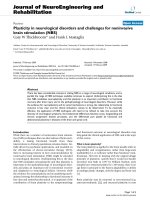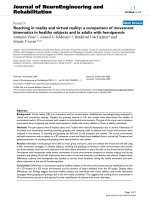Báo cáo hóa học: " Duality in nondifferentiable minimax fractional programming with B-(p, r)-invexity" pot
Bạn đang xem bản rút gọn của tài liệu. Xem và tải ngay bản đầy đủ của tài liệu tại đây (786.16 KB, 14 trang )
RESEARCH Open Access
Duality in nondifferentiable minimax fractional
programming with B-(p, r)-invexity
Izhar Ahmad
1,2*
, SK Gupta
3
, N Kailey
4
and Ravi P Agarwal
1,5
* Correspondence: drizhar@kfupm.
edu.sa
1
Department of Mathematics and
Statistics, King Fahd University of
Petroleum and Minerals, Dhahran
31261, Saudi Arabia
Full list of author information is
available at the end of the article
Abstract
In this article, we are concerned with a nondifferentiable minimax fractional
programming problem. We derive the sufficient condition for an optimal solution to
the problem and then establish weak, strong, and strict converse duality theorems
for the problem and its dual problem under B-(p, r)-invexity assumptions. Examples
are given to show that B-(p, r)-invex functions are generalization of (p, r)-invex and
convex functions
AMS Subject Classification: 90C32; 90C46; 49J35.
Keywords: nondifferentiable fractional programming, optimality conditions, B-(p, r)-
invex function, duality theorems
1 Introduction
The mathematical programming problem in which the objective function is a ratio of
two numerical functions is cal led a fractional programming problem. Fractional pro-
gramming is used in various fields of study. Most extensively, it is used in business
and economic situations, mainly in the situations of deficit of financial resources. Frac-
tional programming problems have arisen in multiobjective programming [1,2], game
theory [3], and goal programm ing [4]. Problems of these type have been the subject of
immense interest in the past few years.
The necessary and sufficient conditions for generalized minimax programming were
first developed by Schmitendorf [ 5]. Tanimoto [6] applied these optimality conditions
to define a dual problem and derived duality theorems. Bector and Bhatia [7] relaxed
the convexity assumptions in the sufficient optimality condition in [5] and also
employed the optimality conditions to construct several dual models which involve
pseudo-convex and quasi-convex functions, and derived weak and strong duality theo-
rems. Yadav and Mukhrjee [8] established the optimality conditions to construct the
two dual problems and derived duality theorems for differentiable fractional minimax
programming. Chandra and Kumar [9] pointed out that the formulation of Yadav and
Mukhrjee [8] has some omissions and inconsistencies and they constructed two modi-
fied dual problems and proved duality theorems for differentiable fractional minimax
programming.
Lai et a l. [10] established necessary and sufficient optimality conditions f or non-dif-
ferentiable minimax fractional problem with generalized c onvexity and applied these
optimality conditions to construct a parametric dual model and also discussed duality
Ahmad et al. Journal of Inequalities and Applications 2011, 2011:75
/>© 2011 Ahmad et al; licensee Springer. This is an O pen Access article distributed under the terms of the Creative Commons Attribution
License ( which permits unrestricted use, distribution, and reproduction in any medium,
provided the original work is properly cited .
theorems. Lai and Lee [11] obtained duality theorems for two parameter-free dual
models of nondifferentiab le minimax fractional problem involving generalized convex-
ity assumptions.
Convexity plays an important role in deriving sufficient conditions and duality for non-
linear programming problems. Hanson [12] introduced the concept of invexity and estab-
lished Karush-Kuhn-Tucker type sufficient optimality conditions for nonlinear
programming problems. These functions were named invex by Craven [13]. Generalized
invexity and duality for multiobjective programming problems are discussed in [14], and
inseparable Hilbert spaces are studied by Soleimani-damaneh [15]. Soleimani-damaneh [16]
provides a family of linear infinite problems or linear semi-infinite problems to characterize
the optimality of nonlinear optimization problems. Recently, Antczak [17] proved optimality
conditions for a class of generalized fractional minimax programming problems involving B-
(p, r)-invexity functions and established duality theorems for various duality models.
In this article, we are motivated by Lai et al. [10], Lai and Lee [11], and Antczak [17]
to discuss sufficient optimality conditions and duality theorems for a nondifferentiable
minimax fractional programming problem with B-(p, r)-i nvexity. This article is orga-
nized as follows: In Section 2, we give some preliminaries. An example which is B-(1,
1)-invex but not (p, r)-invex is exemplified. We also illustrate another example which
(-1, 1)-invex but convex. In Sect ion 3, we establish the sufficient optimality conditions.
Duality results are presented in Section 4.
2 Notations and prelominaries
Definition 1.Letf : X ® R (where X ⊆ R
n
)bedifferentiablefunction,andletp, r be
arbitrary real numbers. Then f is said to be (p, r)-invex (strictly (p, r)-invex) with
respect to h at u Î X on X if there exists a function h : X × X ® R
n
such that, for all
x Î X, the inequalities
1
r
e
r(f (x)
≥
1
r
e
r(f (u)
1+
r
p
∇f (u)(e
pη(x,u)
− 1)
(> if x = u)forp =0, r =0
,
1
r
e
r(f (x)
≥
1
r
e
r(f (u)
1+r∇f (u)(e
pη(x,u)
− 1)
(> ifx = u)forp =0, r =0,
f (x) −f (u) ≥
1
p
∇f (u)(e
pη(x,u)
− 1)(> if x = u)forp =0, r =0,
f
(
x
)
− f
(
u
)
≥∇f
(
u
)
η
(
x, u
)(
> if x = u
)
for p =0, r =0,
hold.
Definition 2 [17]. The different iable function f : X ® R (where X ⊆ R
n
)issaidtobe
(strictly) B-(p, r)-invex with respect to h and b at u Î X on X if there exists a function
h : X × X ® R
n
and a function b : X × X ® R
+
such that, for all x Î X, the following
inequalities
1
r
b(x, u)(e
r(f (x)−f(u))
− 1) ≥
1
p
∇f (u)(e
pη(x,u)
− 1)(> if x = u)forp =0, r =0
,
1
r
b(x, u)(e
r(f (x)−f(u))
− 1) ≥∇f( u) η(x, u)(> ifx = u)forp =0, r =0,
b
(x, u)(f (x) −f (u)) ≥
1
p
∇f (u)(e
pη(x,u)
− 1)(> ifx = u)forp =0, r =0,
b(
x, u
)(
f
(
x
)
− f
(
u
))
≥∇f
(
u
)
η
(
x, u
)(
> ifx = u
)
for p =0, r =0,
Ahmad et al. Journal of Inequalities and Applications 2011, 2011:75
/>Page 2 of 14
hold. f is said to be (strictly) B-(p, r)-invex with respect to h and b on X if it is B-(p,
r)-invex with respect to same h and b at each u Î X on X.
Remark 1 [17]. It should be pointed out that the exponentials appearing on the right-
hand sides of the inequalities above are understood to be taken componentwise and 1
= (1, 1, , 1) Î R
n
.
Example 1. Let X = [8.75, 9.15] ⊂ R. Consider the function f : X ® R defined by
f
(
x
)
=log
(
sin
2
x
).
Let h : X × X ® R be given by
η
(
x, u
)
=12
(
1+u
).
To prove that f is (-1, 1)-invex, we have to show that
1
r
e
rf (x)
−
1
r
e
rf (u)
1+
r
p
∇f (u)
e
pη(x,u)
− 1
≥ 0, forp = −1and r =1
.
Now, consider
ϕ = e
f (x)
− e
f (u)
1 −∇f (u)
e
−η(x,u)
− 1
=sin
2
x +sin2u
e
−12(1+u)
− 1
− sin
2
u
≥
0∀x, u ∈ X,
as can be seen form Figure 1.
Hence, f is (-1, 1)-invex.
Further, for x = 8.8 and u = 9.1, we have
ϑ = f (x) −f (u) − (x −u)
T
∇f (u)
=2log
sin x
sin u
−
(x − u)sin2u
sin
2
u
= −
0.570057
22
5
<
0
Thus f is not convex function on X.
Example 2. Let X = [0.25, 0.45] ⊂ R. Consider the function f : X ® R defined by
f
(
x
)
= −x
2
+log
(
8
√
x
).
Let h : X × X ® R and b : X × X ® R
+
be given by
η
(
x, u
)
=log
(
1+2u
2
)
and
b(
x, u
)
=4sin
2
x +sin
2
u
,
respectively.
The function f defined above is B-(1, 1)-invex as
φ = b(x, u)(e
(f (x)−f (u))
− 1) −∇f(u)(e
η(x,u)
− 1)
=
4sin
2
x +sin
2
u
e
(u
2
−x
2
)
x
u
− 1
−
u − 4u
3
≥
0 ∀x, u ∈ X,
as can be seen from Figure 2.
Ahmad et al. Journal of Inequalities and Applications 2011, 2011:75
/>Page 3 of 14
Figure 1 = sin
2
x + sin 2u(e
-12(1+u)
- 1) - sin
2
u.
Figure 2
φ =
4sin
2
x +sin
2
u
e
(u
2
−x
2
)
x
u
− 1
−
u − 4u
3
.
Ahmad et al. Journal of Inequalities and Applications 2011, 2011:75
/>Page 4 of 14
However, it is not (p, r) invex for all p, r Î (-10
17
,10
17
)as
ψ =
1
r
e
rf (x)
−
1
r
e
rf (u)
1+
r
p
∇f (u)(e
pη(x,u)
− 1)
=
1
r
e
1.461296176×r
−
1
r
e
1.469291258×r
1+0.45×
r
p
e
0.30 21765186×p
− 1
(for x = 0.4 and u = 0.42)
<0 as can be seen from Figure 3.
Hence f is B-(1, 1)-invex but not (p, r)-invex.
In this article, we consider the following nondifferentiable minimax fractional pro-
gramming problem:
(FP)
min
x∈R
n
sup
y∈Y
l(x, y)+(x
T
Dx)
1/2
m(x, y) − (x
T
Ex)
1/2
subject to g
(
x
)
≤ 0, x ∈ X
where Y is a compact subset of R
m
, l(., .): R
n
× R
m
® R, m(., .): R
n
× R
m
® R,areC
1
functions on R
n
× R
m
and g(.): R
n
® R
p
is C
1
function on R
n
. D and E are n × n posi-
tive semidefinite matrices.
Let S ={x Î X : g(x) ≤ 0} denote the set of all feasible solutions of (FP).
Any point x Î S is called the feasible point of (FP). For each (x, y) Î R
n
× R
m
,we
define
φ(x, y)=
l(x, y)+(x
T
Dx)
1/2
m
(
x, y
)
−
(
x
T
Ex
)
1/2
,
Figure 3
ψ =
1
r
e
1.461296176×r
−
1
r
e
1.469291258×r
1+0.45×
r
p
e
0.3021765186×p
− 1
.
Ahmad et al. Journal of Inequalities and Applications 2011, 2011:75
/>Page 5 of 14
such that for each (x, y) Î S × Y,
l
(
x, y
)
+
(
x
T
Dx
)
1/2
≥ 0andm
(
x, y
)
−
(
x
T
Ex
)
1/2
> 0
.
For each x Î S, we define
H
(
x
)
= {h ∈ H : g
h
(
x
)
=0}
,
where
H = {1, 2, , p},
Y(x)=
y ∈ Y :
l(x,y)+(x
T
Dx)
1/2
m(x,y)−(x
T
Ex)
1/2
=sup
z∈Y
l(x,z)+(x
T
Dx)
1/2
m(x,z)−(x
T
Ex)
1/2
.
K(x)=
(s, t,
˜
y) ∈ N × R
s
+
× R
ms
:1≤ s ≤ n +1,t =(t
1
, t
2
, , t
s
) ∈ R
s
+
with
s
i=1
t
i
=1,
˜
y =(
¯
y
1
,
¯
y
2
, ,
¯
y
s
)with
¯
y
i
∈ Y(x)(i =1,2, , s)
.
Since l and m are continuously differentiable and Y is compact in R
m
, it follows that
for each x* Î S, Y (x*) ≠ ∅, and for any
¯
y
i
∈ Y
(
x
∗
)
, we have a positive constant
k
◦
= φ(x
∗
,
¯
y
i
)=
l(x
∗
,
¯
y
i
)+(x
∗
T
Dx
∗
)
1/2
m
(
x
∗
,
¯
y
i
)
−
(
x
∗
T
Ex
∗
)
1/2
.
2.1 Generalized Schwartz inequality
Let A be a positive-semidefinite matrix of order n. Then, for all, x, w Î R
n
,
x
T
Aw ≤
(
x
T
Ax
)
1
2
(
w
T
Aw
)
1
2
.
(1)
Equality holds if for some l ≥ 0,
A
x
= λA
w.
Evidently, if
(
w
T
Aw
)
1
2
≤
1
, we have
x
T
Aw ≤
(
x
T
Ax
)
1
2
.
If the functions l, g,andm in problem (FP) are continuously differentiable with
respect to x Î R
n
, then Lai et al. [10] derived the following necessary conditions for
optimality of (FP).
Theorem 1 (Necessary conditions). If x* is a solution of (FP) satisfying x*
T
Dx* >0,
x*
T
Ex* >0, and ∇g
h
(x*), h Î H(x*) are linearly independent, t hen there exist
(
s, t
∗
,
¯
y
)
∈ K
(
x
∗
)
, k
o
Î R
+
, w, v Î R
n
and
μ
∗
∈ R
p
+
such that
s
i=1
t
∗
i
∇l(x
∗
,
¯
y
i
)+Dw − k
◦
(∇m(x
∗
,
¯
y
i
) − Ev)
+ ∇
p
h
=1
μ
∗
h
g
h
(x
∗
)=0
,
(2)
l(x
∗
,
¯
y
i
)+(x
∗
T
Dx
∗
)
1
2
− k
◦
m(x
∗
,
¯
y
i
) − (x
∗
T
Ex
∗
)
1
2
=0, i =1,2, , s
,
(3)
p
h
=1
μ
∗
h
g
h
(x
∗
)=0
,
(4)
Ahmad et al. Journal of Inequalities and Applications 2011, 2011:75
/>Page 6 of 14
t
∗
i
≥ 0(i =1,2, , s),
s
i
=1
t
∗
i
=1,
(5)
⎧
⎪
⎨
⎪
⎩
w
T
Dw ≤ 1, v
T
Ev ≤ 1
,
(x
∗
T
Dx
∗
)
1/2
= x
∗
T
Dw,
(x
∗
T
Ex
∗
)
1/2
= x
∗
T
Ev.
(6)
Remark 2. All the theorems in this article will be proved only in the case when p ≠ 0,
r ≠ 0. The proofs in the other cases are easier than in this one. It follows from the
form of inequalities which are given in Definition 2. Moreover, without limiting the
generality considerations, we shall assume that r >0.
3 Sufficient conditions
Under smooth conditions, say, convexity and generalized convexity as well as differ-
entiability, optimality conditions for these problems have been studied in the past few
years. The intrinsic presence of nonsmoothness (the necessity to deal with nondifferen-
tiable functions, sets with nonsmooth boundaries, and set-valued mappings) is one of
the most characteristic features of modern variational analysis (see [18,19]). Recently,
nonsmooth optimizations have been studied by some authors [20-23]. The optimality
conditions for approximate solutions in multiobjective optimization problems have
been studied by Gao et al. [24] and for nondifferentiable multiobjective case by Kim et
al.[25].Now,weprovethesufficientcondition for optimality of (FP) under the
assumptions of B-(p, r)-invexity.
Theorem 2 (Sufficient condition). Let x* be a feasible solution of (FP) and there exist
a positive integer s,1≤ s ≤ n +1,
t
∗
∈ R
s
+
,
¯
y
i
∈ Y
(
x
∗
)(
i =1,2, s
)
, k
o
Î R
+
, w, v Î R
n
and
μ
∗
∈ R
p
+
satisfying the relations (2)-(6). Assume that
(i)
s
i
=1
t
∗
i
(l(.,
¯
y
i
)+(.)
T
Dw − k
◦
(m(.,
¯
y
i
) − (.)
T
Ev)
)
is B-(p, r)-invex at x*onS with
respect to h and b satisfying b(x, x*) > 0 for all x Î S,
(ii)
p
h
=1
μ
∗
h
g
h
(.
)
is B
g
-(p, r)-invex at x*onS with respect to the same function h, and
with respect to the function b
g
, not necessarily, equal to b.
Then x* is an optimal solution of (FP).
Proof. Suppose to the contrary that x* is not an optimal solution of (FP). Then there
exists an
¯
x
∈ S
such that
sup
y∈Y
l(
¯
x, y)+(
¯
x
T
D
¯
x)
1/2
m(
¯
x, y) −(
¯
x
T
E
¯
x)
1/2
< sup
y∈Y
l(x
∗
, y)+(x
∗
T
Dx
∗
)
1/2
m
(
x
∗
, y
)
−
(
x
∗
T
Ex
∗
)
1/2
.
We note that
sup
y∈Y
l(x
∗
, y)+(x
∗
T
Dx
∗
)
1/2
m
(
x
∗
, y
)
−
(
x
∗
T
Ex
∗
)
1/2
=
l(x
∗
,
¯
y
i
)+(x
∗
T
Dx
∗
)
1/2
m
(
x
∗
,
¯
y
i
)
−
(
x
∗
T
Ex
∗
)
1/2
= k
◦
,
Ahmad et al. Journal of Inequalities and Applications 2011, 2011:75
/>Page 7 of 14
for
¯
y
i
∈ Y
(
x
∗
)
, i = 1, 2, , s and
l(
¯
x,
¯
y
i
)+(
¯
x
T
D
¯
x)
1/2
m
(
¯
x,
¯
y
i
)
−
(
¯
x
T
E
¯
x
)
1/2
≤ sup
y∈Y
l(
¯
x, y)+(
¯
x
T
D
¯
x)
1/2
m
(
¯
x, y
)
−
(
¯
x
T
E
¯
x
)
1/2
.
Thus, we have
l(
¯
x,
¯
y
i
)+(
¯
x
T
D
¯
x)
1/2
m
(
¯
x,
¯
y
i
)
−
(
¯
x
T
E
¯
x
)
1/2
< k
◦
,fori =1,2, ,s
.
It follows that
l
(
¯
x,
¯
y
i
)
+
(
¯
x
T
D
¯
x
)
1/2
− k
◦
(
m
(
¯
x,
¯
y
i
)
−
(
¯
x
T
E
¯
x
)
1/2
)
< 0, for i =1,2, ,s
.
(7)
From (1), (3), (5), (6) and (7), we obtain
s
i=1
t
∗
i
{l(
¯
x,
¯
y
i
)+
¯
x
T
Dw − k
◦
(m(
¯
x,
¯
y
i
) −
¯
x
T
Ev)}
≤
s
i=1
t
∗
i
{l(
¯
x,
¯
y
i
)+(
¯
x
T
D
¯
x)
1
2
− k
◦
(m(
¯
x,
¯
y
i
) − (
¯
x
T
E
¯
x)
1
2
)}
< 0=
s
i=1
t
∗
i
{l(x
∗
,
¯
y
i
)+(x
∗
T
Dx
∗
)
1
2
− k
◦
(m(x
∗
,
¯
y
i
) − (x
∗
T
Ex
∗
)
1
2
)
}
=
s
i
=1
t
∗
i
{l(x
∗
,
¯
y
i
)+x
∗
T
Dw − k
◦
(m(x
∗
,
¯
y
i
) − x
∗
T
Ev)}.
It follows that
s
i=1
t
∗
i
{l(
¯
x,
¯
y
i
)+
¯
x
T
Dw − k
◦
(m(
¯
x,
¯
y
i
) −
¯
x
T
Ev)}
<
s
i
=1
t
∗
i
{l(x
∗
,
¯
y
i
)+x
∗
T
Dw − k
◦
(m(x
∗
,
¯
y
i
) − x
∗
T
Ev)}
.
(8)
As
s
i
=1
t
∗
i
(l(.,
¯
y
i
)+(.)
T
Dw − k
◦
(m(.,
¯
y
i
) − (.)
T
Ev)
)
is B-(p, r)-invex at x*onS with
respect to h and b, we have
1
r
b(x, x
∗
)
e
r
s
i=1
t
∗
i
(l(x,
¯
y
i
)+x
T
Dw−k
◦
(m(x,
¯
y
i
)−x
T
Ev)) −
s
i=1
t
∗
i
(l(x
∗
,
¯
y
i
)+x
∗T
Dw−k
◦
(m(x
∗
,
¯
y
i
)−x
∗T
Ev))
− 1
≥
1
p
s
i=1
t
∗
i
(∇l(x
∗
,
¯
y
i
)+Dw − k
◦
(∇m(x
∗
,
¯
y
i
) − Ev))
{e
pη(x,x
∗
)
− 1}
holds for all x Î S,andsofor
x
=
¯
x
.Using(8)and
b(
¯
x, x
∗
)
>
0
together with the
inequality above, we get
1
p
s
i=1
t
∗
i
(∇l(x
∗
,
¯
y
i
)+Dw − k
◦
(∇m(x
∗
,
¯
y
i
) − Ev))
{e
pη(
¯
x,x
∗
)
− 1} < 0
.
(9)
From the feasibility of
¯
x
together with
μ
∗
h
≥
0
, h Î H, we have
p
h
=1
μ
∗
h
g
h
(
¯
x) ≤ 0
.
(10)
Ahmad et al. Journal of Inequalities and Applications 2011, 2011:75
/>Page 8 of 14
By B
g
-(p, r)-invexity of
p
h
=1
μ
∗
h
g
h
(.
)
at x*onS with respect to the same function h, and
with respect to the function b
g
, we have
1
r
b
g
(
¯
x, x
∗
)
⎧
⎨
⎩
e
r
p
h=1
μ
∗
h
g
h
(
¯
x) −
p
h=1
μ
∗
h
g
h
(x
∗
)
− 1
⎫
⎬
⎭
≥
1
p
p
h=1
∇μ
∗
h
g
h
(x
∗
)
e
pη(
¯
x,x
∗
)
− 1
.
Since b
g
(x, x*) ≥ 0 for all x Î S then by (4) and (10), we obtain
1
p
p
h
=1
∇μ
∗
h
g
h
(x
∗
){e
pη(
¯
x,x
∗
)
− 1}≤0
.
(11)
By adding the inequalities (9) and (11), we have
1
p
s
i=1
t
∗
i
(∇l(x
∗
,
¯
y
i
)+Dw −k
◦
(∇m(x
∗
,
¯
y
i
) − Ev)) +
p
h=1
∇μ
∗
h
g
h
(x
∗
)
{
e
pη(
¯
x,x
∗
)
− 1
}
< 0
,
which contradicts (2). Hence the result. □
4 Duality results
In this section, we consider the following dual to (FP):
(FD)max
(s,t,
¯
y)∈K(a )
sup
(
a,μ,k,v,w
)
∈H
1
(
s,t,
¯
y
)
k
,
where
H
1
(
s, t,
¯
y
)
denotes the set of all
(
a, μ, k, v, w
)
∈ R
n
× R
p
+
× R
+
× R
n
× R
n
satisfy-
ing
s
i=1
t
i
{∇l(a,
¯
y
i
)+Dw − k(∇m(a,
¯
y
i
) − Ev)} + ∇
p
h
=1
μ
h
g
h
(a)=0
,
(12)
s
i
=1
t
i
{l(a,
¯
y
i
)+a
T
Dw − k(m(a,
¯
y
i
) − a
T
Ev)}≥0
,
(13)
p
h
=1
μ
h
g
h
(a) ≥ 0
,
(14)
(
s, t,
¯
y
)
∈ K
(
a
),
(15)
w
T
Dw
≤
1, v
T
Ev
≤
1
.
(16)
If, for a triplet
(
s, t,
¯
y
)
∈ K
(
a
)
,theset
H
1
(
s, t,
¯
y
)
=
∅
,thenwedefinethesupremum
over it to be -∞. For convenience, we let
ψ
1
(.) =
s
i
=1
t
i
{l(.,
¯
y
i
)+(.)
T
Dw − k(m(.,
¯
y
i
) − (.)
T
Ev)}
.
Ahmad et al. Journal of Inequalities and Applications 2011, 2011:75
/>Page 9 of 14
Let S
FD
denote a set of all feasible solutions for problem (FD). Moreover, let S
1
denote
S
1
= {a ∈ R
n
:
(
a, μ, k, v, w, s, t,
¯
y
)
∈ S
FD
}
.
Now we derive the following weak, strong, and strict converse duality theorems.
Theorem 3 (Weak dualit y). Let x beafeasiblesolutionof(P)and
(
a, μ, k, v, w, s, t,
¯
y
)
be a feasible of (FD). Let
(i)
s
i
=1
t
i
(l(.,
¯
y
i
)+(.)
T
Dw −k(m(.,
¯
y
i
) − (.)
T
Ev)
)
is B-(p, r)-invex at a on S ∪ S
1
with
respect to h and b satisfying b(x, a)>0,
(ii)
p
h
=1
μ
h
g
h
(.
)
is B
g
-(p, r)-invex at a on S ∪ S
1
with respe ct to the same function h
and with respect to the function b
g
, not necessarily, equal to b.
Then,
sup
y∈Y
l(x, y)+(x
T
Dx)
1/2
m
(
x, y
)
−
(
x
T
Ex
)
1/2
≥ k
.
(17)
Proof. Suppose to the contrary that
sup
y∈Y
l(x, y)+(x
T
Dx)
1/2
m
(
x, y
)
−
(
x
T
Ex
)
1/2
< k
.
Then, we have
l
(
x,
¯
y
i
)
+
(
x
T
Dx
)
1/2
− k
(
m
(
x,
¯
y
i
)
−
(
x
T
Ex
)
1/2
)
< 0, for all
¯
y
i
∈ Y
.
It follows from (5) that
t
i
{l
(
x,
¯
y
i
)
+
(
x
T
Dx
)
1/2
− k
(
m
(
x,
¯
y
i
)
−
(
x
T
Ex
)
1/2
}≤0
,
(18)
with at least one strict inequality, since t =(t
1
, t
2
, , t
s
) ≠ 0.
From (1), (13), (16) and (18), we have
ψ
1
(x)=
s
i=1
t
i
{l(x,
¯
y
i
)+x
T
Dw − k(m(x,
¯
y
i
) − x
T
Ev)}
≤
s
i=1
t
i
{l(x,
¯
y
i
)+(x
T
Dx)
1
2
− k(m(x,
¯
y
i
) − (x
T
Ex)
1
2
)
}
< 0 ≤
s
i=1
t
i
{l(a,
¯
y
i
)+a
T
Dw −k(m(a,
¯
y
i
) − a
T
Ev)}
= ψ
1
(
a
)
.
Hence
ψ
1
(
x
)
<ψ
1
(
a
).
(19)
Since
s
i
=1
t
i
(l(.,
¯
y
i
)+(.)
T
Dw −k(m(.,
¯
y
i
) − (.)
T
Ev)
)
is B-(p, r)-invex at a on S ∪ S
1
with
respect to h and b, we have
Ahmad et al. Journal of Inequalities and Applications 2011, 2011:75
/>Page 10 of 14
1
r
b(x, a)
e
r
s
i=1
t
i
(l(x,
¯
y
i
)+x
T
Dw−k(m(x,
¯
y
i
)−x
T
Ev)) −
s
i=1
t
i
(l(a,
¯
y
i
)+a
T
Dw−k(m(a,
¯
y
i
)−a
T
Ev))
− 1
≥
1
p
s
i=1
t
i
(∇l(a,
¯
y
i
)+Dw − k(∇m( a ,
¯
y
i
) − Ev))
{e
pη(x,a)
− 1}.
From (19) and b(x, a) > 0 together with the inequality above, we get
1
p
s
i=1
t
i
(∇l(a,
¯
y
i
)+Dw −k(∇m(a,
¯
y
i
) − Ev))
{e
pη(x,a)
− 1} < 0
.
(20)
Using the feasibility of x together with μ
h
≥ 0, h Î H, we obtain
p
h
=1
μ
h
g
h
(x) ≤ 0
.
(21)
From hypothesis (ii), we have
1
r
b
g
(x, a)
⎧
⎨
⎩
e
r
p
h=1
μ
h
g
h
(x) −
p
h=1
μ
h
g
h
(a)
− 1
⎫
⎬
⎭
≥
1
p
p
h=1
∇μ
h
g
h
(a){e
pη(x,a)
− 1}
.
As b
g
(x, a) ≥ 0 then by (14) and (21), we obtain
1
p
p
h
=1
∇μ
h
g
h
(a){e
pη(x,a)
− 1}≤0
.
(22)
Thus, by (20) and (22), we obtain the inequality
1
p
s
i=1
t
i
(∇l(a,
¯
y
i
)+Dw − k(∇m(a,
¯
y
i
) − Ev)) +
p
h
=1
∇μ
h
g
h
(a)
{e
pη(x,a)
− 1} < 0
,
which contradicts (12). Hence (17) holds. □
Theorem 4 (Strong duality). Let x* be an optimal solution of (FP) and ∇g
h
(x*), h Î H
(x*) is linearly independent. Then there exist
(
¯
s,
¯
t,
¯
y
∗
)
∈ K
(
x
∗
)
and
(
x
∗
, ¯μ,
¯
k,
¯
v,
¯
w
)
∈ H
1
(
¯
s,
¯
t,
¯
y
∗
)
such that
(
x
∗
, ¯μ,
¯
k,
¯
v,
¯
w,
¯
s,
¯
t,
¯
y
∗
)
is a feasible solution of (F D).
Further, if the hypotheses of weak duality theorem are satisfied for all feasible solutions
(
a, μ, k, v, w, s, t,
¯
y
)
of (FD), then
(
x
∗
, ¯μ,
¯
k,
¯
v,
¯
w,
¯
s,
¯
t,
¯
y
∗
)
is an optimal solution of (FD), and
the two objectives have the same optimal values.
Proof.Ifx* be an optimal solution of (FP) and ∇g
h
(x*), h Î H(x*) is linearly indepen-
dent, then by Theorem 1, there exist
(
¯
s,
¯
t,
¯
y
∗
)
∈ K
(
x
∗
)
and
(
x
∗
, ¯μ,
¯
k,
¯
v,
¯
w
)
∈ H
1
(
¯
s,
¯
t,
¯
y
∗
)
such that
(
x
∗
, ¯μ,
¯
k,
¯
v,
¯
w,
¯
s,
¯
t,
¯
y
∗
)
is feasible for (FD) and problems (FP) and (FD) have the
same objective values and
¯
k =
l(x
∗
,
¯
y
∗
i
)+(x
∗
T
Dx
∗
)
1/2
m(x
∗
,
¯
y
∗
i
) − (x
∗
T
Ex
∗
)
1/2
.
The optimality of this feasible solution for (FD) thus follows from Theorem 3. □
Theorem 5 (Strict converse duality). Let x*and
(
¯
a, ¯μ,
¯
k,
¯
v,
¯
w,
¯
s,
¯
t,
¯
y
∗
)
be the optimal
solutions of (FP) and (FD), respectively, and ∇g
h
(x*), h Î H(x*) is linearly independent.
Ahmad et al. Journal of Inequalities and Applications 2011, 2011:75
/>Page 11 of 14
Suppose that
s
i
=1
t
i
(l(.,
¯
y
i
)+(.)
T
Dw −
¯
k(m(.,
¯
y
i
) − (.)
T
Ev)
)
is strictly B-(p, r)-invex at a
on S ∪ S
1
with respect to h and b satisfying b(x, a)>0forallx Î S. Furthermore,
assume that
p
h
=1
μ
h
g
h
(.
)
is B
g
-(p, r)-invex at a on S ∪ S
1
with respect to the same func-
tion h and with respect to the function b
g
, but not necessarily, equal to the function b.
Then
x
∗
=
¯
a
, that is,
¯
a
is an optimal point in (FP) and
sup
y∈Y
l(
¯
a,
¯
y
∗
)+(
¯
a
T
D
¯
a)
1/2
m
(
¯
a,
¯
y
∗
)
−
(
¯
a
T
E
¯
a
)
1/2
=
¯
k
.
Proof. We shall assume that
x
∗
=
¯
a
and reach a contradiction. From the strong dua-
lity theorem (Theorem 4), it follows that
sup
y∈Y
l(x
∗
,
¯
y
∗
)+(x
∗
T
Dx
∗
)
1/2
m
(
x
∗
,
¯
y
∗
)
−
(
x
∗
T
Ex
∗
)
1/2
=
¯
k
.
(23)
By feasibility of x* together with μ
h
≥ 0, h Î H, we obtain
p
h
=1
μ
h
g
h
(x
∗
) ≤ 0
.
(24)
By assumption,
p
h
=1
μ
h
g
h
(.
)
is B
g
-(p, r)-invex at a on S ∪ S
1
with respect to h and with
respect to the b
g
. Then, by Definition 2, there exists a function b
g
such that b
g
(x, a) ≥ 0
for all x Î S and a Î S
1
. Hence by (14) and (24),
1
r
b
g
(x
∗
,
¯
a)
⎧
⎨
⎩
e
r
p
h=1
μ
h
g
h
(x
∗
) −
p
h=1
μ
h
g
h
(
¯
a)
− 1
⎫
⎬
⎭
≤ 0
.
Then, from Definition 2, we get
1
p
p
h
=1
∇μ
h
g
h
(
¯
a){e
pη(x
∗
,
¯
a)
− 1}≤0
.
(25)
Therefore, by (25), we obtain the inequality
1
p
s
i=1
t
i
(∇l(
¯
a,
¯
y
i
)+Dw −
¯
k(∇m(
¯
a,
¯
y
i
) − Ev))
{e
pη(x
∗
,
¯
a)
− 1}≥0
.
As
s
i
=1
t
i
(l(.,
¯
y
i
)+(.)
T
Dw −
¯
k(m(.,
¯
y
i
) − (.)
T
Ev)
)
is strictly B-(p, r)-invex with respect to
h and b at
¯
a
on S ∪ S
1
. Then, by the Definition of strictly B-(p, r)-invexity and from
above inequality, it follows that
1
r
b(x
∗
,
¯
a)×
e
r
s
i=1
t
i
(l(x
∗
,
¯
y
i
)+x
∗T
Dw−
¯
k(m(x
∗
,
¯
y
i
)−x
∗T
Ev))−
s
i=1
t
i
(l(
¯
a,
¯
y
i
)+
¯
a
T
Dw−
¯
k(m(
¯
a,
¯
y
i
)−
¯
a
T
Ev))
− 1
> 0
.
Ahmad et al. Journal of Inequalities and Applications 2011, 2011:75
/>Page 12 of 14
From the hypothesis
b(
x
∗
,
¯
a
)
>
0
, and the above inequality, we get
s
i=1
t
i
(l(x
∗
,
¯
y
i
)+x
∗
T
Dw −
¯
k(m(x
∗
,
¯
y
i
) − x
∗
T
Ev))
−
s
i
=1
t
i
(l(
¯
a,
¯
y
i
)+
¯
a
T
Dw −
¯
k(m(
¯
a,
¯
y
i
) −
¯
a
T
Ev)) > 0
.
Therefore, by (13),
s
i
=1
t
i
(l(x
∗
,
¯
y
i
)+x
∗
T
Dw −
¯
k(m(x
∗
,
¯
y
i
) − x
∗
T
Ev)) > 0
.
Since t
i
≥ 0, i = 1, 2, , s, therefore there exists i* such that
l(x
∗
,
¯
y
∗
i
)+x
∗
T
Dw −
¯
k(m(x
∗
,
¯
y
∗
i
) − x
∗
T
Ev) > 0
.
Hence, we obtain the following inequality
l(x
∗
,
¯
y
∗
i
)+(x
∗
T
Dx
∗
)
1/2
m(x
∗
,
¯
y
∗
i
) − (x
∗
T
Ex
∗
)
1/2
>
¯
k
,
which contradicts (23). Hence the results. □
5 Concluding remarks
It is not clear that whether duality in nondifferentiable minimax fractio nal program-
ming with B-(p, r)-invexity can be further extended to second-order case.
6 Competing interests
The authors declare that they have no competing interests.
7 Authors’ contributions
All authors co ntributed equally and significantly in writing this paper. All authors read
and approved the final manuscript.
Acknowledgements
Izhar Ahmad thanks the King Fahd University of Petroleum and Minerals for the support under the Fast Track Project
no. FT100023. Ravi P. Agarwal gratefully acknowledges the support provided by the King Fahd University of Petroleum
and Minerals to carry out this research. The authors wish to thank the referees for their several valuable suggestions
which have considerably improved the presentation of this article.
Author details
1
Department of Mathematics and Statistics, King Fahd University of Petroleum and Minerals, Dhahran 31261, Saudi
Arabia
2
Department of Mathematics, Aligarh Muslim University, Aligarh-202 002, India
3
Department of Mathematics,
Indian Institute of Technology Patna, Patna-800 013, India
4
School of Mathematics and Computer Applications, Thapar
University, Patiala-147 004, India
5
Department of Mathematics, Texas A & M University - Kingsville, 700 University Blvd.
Kingsville, TX 78363-8202, USA
Received: 6 November 2010 Accepted: 30 September 2011 Published: 30 September 2011
References
1. Gulati, TR, Ahmad, I: Efficiency and duality in multiobjective fractional programming. Opsearch. 32,31–43 (1990)
2. Weir, T: A dual for multiobjective fractional programming. J Inf Optim Sci. 7, 261–269 (1986)
3. Chandra, S, Craven, BD, Mond, B: Generalized fractional programming duality: a ratio game approach. J Aust Math Soc
B. 28, 170–180 (1986). doi:10.1017/S0334270000005282
4. Charnes, A, Cooper, WW: Goal programming and multiobjective optimization, Part I. Eur J Oper Res. 1,39–54 (1977).
doi:10.1016/S0377-2217(77)81007-2
5. Schmitendorf, WE: Necessary conditions and sufficient optimality conditions for static minimax problems. J Math Anal
Appl. 57, 683–693 (1977). doi:10.1016/0022-247X(77)90255-4
Ahmad et al. Journal of Inequalities and Applications 2011, 2011:75
/>Page 13 of 14
6. Tanimoto, S: Duality for a class of nondifferentiable mathematical programming problems. J Math Anal Appl. 79,
283–294 (1981)
7. Bector, CR, Bhatia, BL: Sufficient optimality and duality for a minimax problems. Utilitas Mathematica. 27, 229–247 (1985)
8. Yadav, SR, Mukherjee, RN: Duality for fractional minimax programming problems. J Aust Math Soc B. 31, 484–492
(1990). doi:10.1017/S0334270000006809
9. Chandra, S, Kumar, V: Duality in fractional minimax programming. J Aust Math Soc A. 58, 376–386 (1995). doi:10.1017/
S1446788700038362
10. Lai, HC, Liu, JC, Tanaka, K: Necessary and sufficient conditions for minimax fractional programming. J Math Anal Appl.
230, 311–328 (1999). doi:10.1006/jmaa.1998.6204
11. Lai, HC, Lee, JC: On duality theorems for a nondifferentiable minimax fractional programming. J Comput Appl Math.
146, 115–126 (2002). doi:10.1016/S0377-0427(02)00422-3
12. Hanson, MA: On sufficiency of the Kuhn-Tucker conditions. J Math Anal Appl. 80, 545–550 (1981). doi:10.1016/0022-
247X(81)90123-2
13. Craven, BD: Invex functions and constrained local minima. Bull Aust Math Soc. 24, 357–366 (1981). doi:10.1017/
S0004972700004895
14. Aghezzaf, B, Hachimi, M: Generalized invexity and duality in multiobjective programming problems. J Global Optim. 18,
91–101 (2000). doi:10.1023/A:1008321026317
15. Soleimani-damaneh, M: Generalized invexity in separable Hilbert spaces. Topology. 48,66–79 (2009). doi:10.1016/j.
top.2009.11.004
16. Soleimani-damaneh, M: Infinite (semi-infinite) problems to characterize the optimality of nonlinear optimization
problems. Eur J Oper Res. 188,49–56 (2008). doi:10.1016/j.ejor.2007.04.026
17. Antczak, T: Generalized fractional minimax programming with B-(p, r)-invexity. Comput Math Appl. 56, 1505–1525
(2008). doi:10.1016/j.camwa.2008.02.039
18. Mordukhovich, BS: Variational Analysis and Generalized Differentiation, I: Basic Theory. Springer, Grundlehren Series
(Fundamental Principles of Mathematical Sciences)330 (2006)
19. Mordukhovich, BS: Variations Analysis and Generalized Differentiation, II: Applications. Springer, Grundlehren Series
(Fundamental Principles of Mathematical Sciences)331 (2006)
20. Agarwal, RP, Ahmad, I, Husain, Z, Jayswal, A: Optimality and duality in nonsmooth multiobjective optimization involving
V-type I invex functions. J Inequal Appl 2010, Article ID 898626 (2010). 14
21. Kim, DS, Lee, HJ: Optimality conditions and duality in nonsmooth multiobjective programs. J Inequal Appl 2010, Article
ID 939537 (2010). 12
22. Soleimani-damaneh, M: Nonsmooth optimization using Mordukhovich’s subdifferential. SIAM J Control Optim. 48,
3403–3432 (2010). doi:10.1137/070710664
23. Soleimani-damaneh, M, Nieto, JJ: Nonsmooth multiple-objective optimization in separable Hilbert spaces. Nonlinear
Anal.
71, 4553–4558 (2009). doi:10.1016/j.na.2009.03.013
24. Gao, Y, Yang, X, Lee, HWJ: Optimality conditions for approximate solutions in multiobjective optimization problems. J
Inequal Appl 2010, Article ID 620928 (2010). 17
25. Kim, HJ, Seo, YY, Kim, DS: Optimality conditions in nondifferentiable G-invex multiobjective programming. J Inequal
Appl 2010, Article ID 172059 (2010). 13
doi:10.1186/1029-242X-2011-75
Cite this article as: Ahmad et al.: Duality in nondifferentiable minimax fractional programming with B-(p, r)-
invexity. Journal of Inequalities and Applications 2011 2011:75.
Submit your manuscript to a
journal and benefi t from:
7 Convenient online submission
7 Rigorous peer review
7 Immediate publication on acceptance
7 Open access: articles freely available online
7 High visibility within the fi eld
7 Retaining the copyright to your article
Submit your next manuscript at 7 springeropen.com
Ahmad et al. Journal of Inequalities and Applications 2011, 2011:75
/>Page 14 of 14









